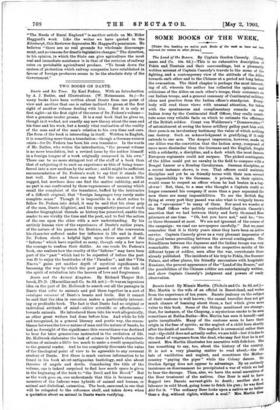Dante and the Animal Kingdom. By Richard Thayer Hol- brook,
Ph.D. (Macmillan and Co. Ss. 6d. net.)—It was an ingenious idea on the part of Dr. Holbrook to search out all the passages in Dante that refer to animals and put them together in a sort of catalogue raisonne of Dante's beasts and birds. But it cannot be said that the idea in execution makes a particularly interest-. ring or profitable book. The fact is that Dante had no original or individual attitude of mind—either scientific or affectionate— towards animals. He introduced them into his work allegorically, as other great writers had done before him. And while he felt and recognised, in a general literary and poetic way, the resem- blance between the lower nature of man and the nature of beasts, he had no foresight of the significance this resemblance was destined to bear for later generations instructed in the evolution of life. Dr. Holbrook elaborates the lack of science in Dante's characteri- sations of animals a little too much to make a result sympathetic to the general reader. And he too completely discounts the value of the theological point of view to be agreeable to any reverent student of Dante. But there is much curious information to be found in his book about antiquarian bestiology, and also about theories of angels and devils. Considering the title of the volume, one is indeed surprised to find how much space is given in the beginning of the book to "the Devil and his Brood." But as the work goes on, one understands that this is because many monsters of the Inferno were hybrids of animal and human, or animal and diabolical, extraction. The book, once read, is one that will be relegated to the reference shelf, and taken down when a quotation about an animal in Dante wants verifying.










































 Previous page
Previous page